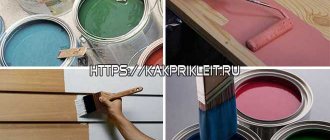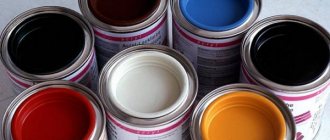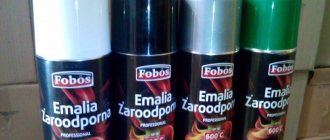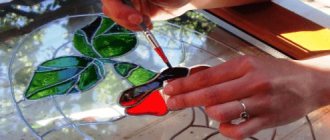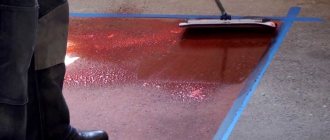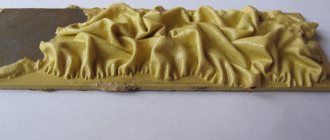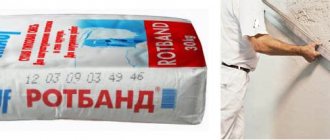Basic composition of enamel paints
Enamels are a type of paint and varnish finishing materials. They consist of pigments combined with special solvents. The presence of varnish components turns the enamel into a suspension that evaporates in air.
- Residual pigments and resins harden when applied to surfaces.
- When dry, the paint layer forms a continuous, opaque film, which can have different textures, depending on the type of paint.
- After the solvent evaporates, the polyvinyl chloride, nitrocellulose or other types of resins present in the enamels become hard.
- The concentration of binders has a decisive influence on the composite properties of enamels and this becomes the main sign of how enamels differ.
The drying time for paints and varnishes after application is 3 hours or more, depending on the type.
Types, palette and composition of enamel
Enamel is a glassy solidified mass of inorganic, mainly oxide composition, sometimes with metal additives, formed through partial or complete melting, applied to a metal or ceramic base.
The beauty of colored enamel, its resistance to chemical influences, and strength are the result of its connection with metal.
Types of enamels
Technical enamels for household trade items (dishes) and for special purposes.
Jewelry enamel is fusible transparent or solid glass, which is applied to copper, silver, gold at a temperature of 1250-1400° C.
Based on light transmission, enamels are divided into transparent, fondon, opaque and opal.
Transparent enamels are made in various colors and brightness. The metal substrate is more or less clearly visible through the enamel. Fondon, a colorless transparent enamel, forms a colorless shiny coating on a metal substrate and is widely used in combination with colored enamels in artistic enameling. Opaque (opal) enamels become completely opaque when mufflers are added to the mixture. Can be obtained in all color shades. Opal (opalistic) enamels are half transparent, i.e. represent the average between transparent and opaque enamels. Thanks to special firing conditions, they acquire a specific appearance: they resemble milky opal.
The manufacturer usually provides recommendations on the selection of the most suitable metal substrates for these enamels. If the firing temperatures of the enamels are low enough, they can be fused onto copper, silver and gold. Enamels specially designed for silver and yellow metal are distinguished by the fact that their color shows up particularly well on these substrates.
Currently, factories from Europe (France, Austria), America and Japan offer us a large color palette of enamels; in Russia, enamels are represented by almost one manufacturer.
It is impossible to give a specific answer to the question of how many enamels of different colors are at the disposal of the enamel artist. It is important what result he achieves and more often uses enamels, the behavior of which during firing he knows well. The more experience an enameller has, the larger the palette of enamels he uses. Often enamel of the same number, but from different brews may differ in color and firing temperature.
Enamels palette
Enamels are marked with the corresponding number and color names, for example, green, blue-gray, topaz yellow, light blue, opal. However, neither the name of the color nor the appearance of the enamel semi-finished product determines the actual color of the enamel. Only when it is fired onto the metal is the final color determined, which, in addition, also depends on the firing conditions. The colors of transparent enamels are greatly influenced by the substrate.
To determine the properties and combination capabilities of the enamel, it is applied and fired on a test plate with various substrates under the same conditions simultaneously. those. the same color on different substrates will look completely different.
Every enameller knows that enamels have certain properties, which under the influence of certain conditions (such as firing temperature, number of firings, properties of other enamels, substrate, partitions) can change, which leads to any surprises.
| Sample | Firing temperature | Product name | GOST or TU |
| Jewelry enamels | TU 2366-011-00303835-95 | ||
| 790oC | Rubinovaya 3 | « | |
| « | Rubinovaya 5 | « | |
| « | Opaque lilac 42 | « | |
| « | Rubinovaya 81 | « | |
| « | Opaque Khaki 6 | « | |
| « | Opaque white 10 | « | |
| « | Opaque white 12 | « | |
| « | Opaque white 13 | « | |
| « | Blue 14 | « | |
| 750oC | Opaque opal 16 | « | |
| 790oC | Violet 18 | « | |
| « | Violet 19 | « | |
| « | Yellow 22 | « | |
| 750oC | Opaque gray 23 | « | |
| 790oC | Opaque blue 28 | « | |
| « | Opaque black 31 | « | |
| « | Colorless fondant 32 | « | |
| 750oC | Opaque gray 33 | « | |
| 790oC | Opaque yellow 34 | « | |
| « | Blue 41 | « | |
| « | Electrician 49 | « | |
| « | Green 58 | « | |
| « | Opaque pistachio 60 | « | |
| « | Opaque blue 63 | « | |
| « | Opaque blue 64 | « | |
| « | Opaque blue 65 | « | |
| « | Light blue 66 | « | |
| « | Opaque dark blue 67 | « | |
| « | Violet 68 | « | |
| « | Green 83 | « | |
| « | Transparent green 84 | « | |
| « | Opaque turquoise 85 | « | |
| « | Opaque blue 91 | « | |
| « | Opaque green 97 | « | |
| « | Opaque dark green 100 | « | |
| « | Dark green 101 | « | |
| « | Sea greens 114 | « | |
| « | Purple 116 | « | |
| « | Brown 117 | « | |
| « | Electrician 120 | « | |
| « | Electrician 122 | « | |
| « | Transparent blue 125 | « | |
| « | Blue 126 | « | |
| « | Blue 127 | « | |
| « | Opaque yellow 130 | « | |
| « | Opaque orange 131 | « | |
| « | Opaque red-orange 132 | « | |
| « | Orange 133 | « | |
| « | Opaque red 134 | « | |
| « | Opaque red 135 | « | |
| « | Rubinovaya 145 | « |
* palette of enamels (Russian manufacturer)
Enamels compositions
According to one of the ancient recipes, enamel is prepared from one part of quartz sand, one part of boric acid and two parts of red lead. To add color, pigments are added: cobalt oxide (blue-black), cadmium oxide (red), cuprum oxide (green).
Modern enamels consist of silicon dioxide, boric anhydride, titanium oxide, aluminum oxide, oxides of alkali and alkaline earth metals, zinc, lead, and various fluorides. Enamel coatings are used wherever it is necessary to achieve long-term chemical resistance of the coating - pipes, chemical reactors, etc.
Enameled metals
Enamellers use copper, precious metals and their alloys for the base in artistic enamel.
Platinum
Of all enamelled metals, platinum has the lowest coefficient of thermal expansion. But at low bending stresses, the enamel chips due to the lack of chemical bonding and low adhesion strength. Only by roughening the surface can satisfactory adhesion of the enamel to the metal be achieved. The colors of enamels on Platinum are stable. Due to the high melting point (1773.5° C), firing the enamel is not difficult. But due to the high cost of Platinum, it has no practical value as a basis for applying enamel.
Gold and yellow metal alloys
The warm yellow color of gold combines harmoniously with all shades of enamel. Gold gives special brightness and expressiveness to red tones. When choosing the color of the enamel, it is necessary to take into account that blue and green enamels have a yellow cast due to the color of the base.
The melting point of yellow metal is quite high (1063 ° C), thermal expansion is slightly higher than that of enamel, so you can safely apply enamel to any object made of yellow metal. Despite the absence of chemical interaction, the adhesion of enamel to metal is strong.
Alloys of yellow metal of 750 standard . The melting points of these alloys are quite high; adhesion strength to enamel is satisfactory; the enamel colors are brighter than when using pure yellow metal.
Silver and silver alloys
Due to its high reflectivity, silver gives transparent - especially green and blue - enamels a brilliant shine, although some enamels interact with silver and change their color. Pure silver has a high melting point (1060.5° C).
In silver alloys, due to the presence of cuprum in them, the adhesion of the enamel to the base is much stronger, and thermal expansion is less, which improves the properties of the coating.
For enameling, a 960-grade alloy is recommended, the melting point of which is quite high and amounts to 900-930 ° C, and the presence of 3% cuprum significantly improves the adhesion of the enamel to the alloy.
Properties of enamels
Since the properties of technical glasses are to a certain extent close to the properties of enamel, Kühn’s definitions were taken as a basis. The special properties of enamel are considered based on the developments of Petzold and Kühn-Gai.
Hardness
Hardness is the resistance of a body to point loads. There are dynamic and static methods for determining hardness. The dynamic method includes the scratching method; to static - hardness measurement according to Brinell, Vickers and Rockwell.
Mohs hardness measurement, i.e. by scratching, based on the relative hardness of the minerals. The measurement scale has ten steps. Harder minerals leave scratches on softer ones. The hardness of enamel is greater than feldspar (6 units) and less than quartz (7 units on the Mohs scale).
In Vickers measurement, a tetrahedral diamond pyramid is pressed into the material and a relationship is established between the force of indentation and the area of the indentation. The Vickers hardness of enamels ranges from 4.5*103 to 6.5*103 MPa.
Elasticity
Elasticity is the ability of a material to return to its original shape and size after removing the load. Under the action of deformation force F (N), the length of the sample changes by l (m).
The modulus of elasticity of technical grades of glass is 5 * 104 - 8 * 104 MPa, quartz glass - about 7.2 * 104 MPa, enamels - 5 * 104 - 7 * 104 MPa.
Gas bubbles located in the enamel were removed
Alkyd enamel
The properties of this inexpensive and reliable paint make it one of the most popular finishing materials. Almost all alkyd enamel paints have many advantages over others.
They are easy to apply to any surface, dry quickly, are elastic and durable. They are successfully used in rooms where high humidity is constantly present, such as kitchens, bathrooms, toilets, bathhouses and swimming pool structures.
The paint can has a special designation, for example, PF-137, where the first number indicates the purpose:
- 1 – for work outside;
- 2 – for painting interior spaces;
- And the next two are about the color number in the color catalog.
Properties.
Enamel glasses differ from ordinary glasses in many ways. Their coefficient of thermal expansion should be slightly less than that of the metal to which they are applied. The enamel melt should form an even continuous layer and adhere well to the base (metal or previous enamel coating). The physical, optical and chemical properties of enamels vary widely. The tensile strength of enamels is usually from 280 to 350 MPa, the longitudinal modulus of elasticity (Young's modulus) is from 50,000 to 60,000 MPa, the coefficient of thermal expansion is from 3×10-5 to 3.5×10-5.
Also on topic:
ART GLASS
For each specific application, the enamel coating should be selected so that its properties correspond to the expected operating conditions. In some cases the most important property may be appearance, gloss, color or whiteness, in others it may be acid resistance, weather resistance or mechanical strength. The enamel on a kitchen stove may not be acid-resistant, but it should withstand sudden temperature changes and have a pleasant appearance. On the contrary, a tank for chemical reagents must be extremely acid-resistant, and its appearance is of secondary importance. Testing the acid resistance of enamel in typical home conditions is very simple: you need to leave a drop of lemon juice on the enamel surface for 15 minutes, and then wash it off and see if the shine is lost. This is a very sensitive test, since lemon juice is a very characteristically aggressive acid, and its effects, even small ones, are easily visible to the eye.
Metal enamel coatings can be of any color, including black and white.
The color of the coating can be selected, and it is stable, i.e. does not disappear or change over time. Both high-gloss and matte enamel surfaces can be obtained. Composition of enamel coating on sheet iron
| COMPOSITION OF ENAMEL COATING ON IRON SHEET | |||
| Ground enamel | Top enamel | ||
| Source materials | Content, % | Source materials | Content, % |
| Feldspar | 30,80 | Dehydrated Borax | 22,80 |
| Silica | 21,54 | Pyrophyllite | 23,90 |
| Borax | 30,80 | Silica | 9,40 |
| Soda Ash | 9,24 | Sodium silicofluoride | 10,70 |
| Fluorspar | 4,08 | Fluorspar | 5,80 |
| Cryolite | 2,10 | Zinc oxide | 3,10 |
| Manganese oxide | 0,62 | Calcium carbonate | 1,20 |
| Cobalt oxide | 0,41 | Zirconium silicate | 21,60 |
| Nickel oxide | 0,41 | Sodium nitrocarbonate | 1,50 |
Examples of enamel compositions for various metals
| EXAMPLES OF ENAMEL COMPOSITION FOR VARIOUS METALS | |||
| Aluminum | Copper | ||
| Source materials | Content, % | Source materials | Content, % |
| Red lead | 37,0 | Red lead | 50,5 |
| Silica | 24,1 | Sodium nitrate | 11,3 |
| Lithium carbonate | 5,1 | Boric acid | 21,8 |
| Sodium carbonate | 14,4 | Silica | 16,4 |
| Potassium carbonate | 11,1 | ||
| Titanium dioxide | 8,3 | ||
Colors are created by various additives: shades of blue - with cobalt or copper oxide, green - with copper, chromium or nickel oxide, pink and maroon - with a mixture of chromium and tin oxides, black - with a mixture of oxides of iron, nickel, manganese, cobalt and chromium.
Also on topic:
METAL ARTISTIC
The reflectance of modern white enamels with the addition of magnesium carbonate always exceeds 60% and, as a rule, ranges from 70 to 80% for pure white. Blueish-white and yellowish-white colors can also be obtained.
Polyurethane enamels
Inexpensive and common paints, widely used in public buildings for painting rooms that are subject to a high degree of wear and tear. For example, in educational institutions they always paint panels and floors.
They are highly durable but take about 24 hours to dry until completely cured. When working with these paints on a large area, it is necessary to use personal protective equipment against toxic fumes and not leave the room closed.
Nitro-enamel paints
The famous paints in aerosol cans are sprayed using a spray gun or an airbrush. This method of application is due to the fact that nitro enamel dries quickly and any painting tools can ruin the surface by brushing across a layer of paint that has had time to harden.
For high-quality metal painting, the surface must be degreased for better compatibility of the coating with the base. They are used mainly for painting metal or wood, as well as for popular graffiti style painting.
Methods of strengthening
To eliminate pathologies associated with tooth enamel, dentists use various techniques, both therapeutic and orthopedic. For severe lesions, crowns or veneers are used. But the best option for every person is to try to preserve their own healthy teeth. What options for strengthening enamel are suitable for an adult:
- Take vitamins and minerals regularly.
- Use preventive and therapeutic agents – gels and pastes containing calcium and fluoride.
- Regularly visit the dental office for preventive examinations and professional cleanings. This will not only protect the enamel, but also prevent the development of caries.
- If the enamel is damaged and visual appeal is lost, you can undergo a whitening procedure, but only after prior consultation with your doctor.
For children, dentists recommend fluoridation, fissure sealing and other procedures aimed at comprehensively strengthening teeth. Parents should pay attention to their child's diet. It should not contain sweet soda or excessive amounts of sweets. Since tooth enamel contains a large number of microelements, it is worth taking vitamins periodically, after consulting with a pediatrician and pediatric dentist.
Acrylic enamels
Acrylic enamel paint occupies a special place among the varieties of finishing materials. It is produced on the basis of water-soluble, dispersed substances and latex.
Polymer acrylic paints can be applied to surfaces of any quality, you just need to sand and clean them to the desired degree of smoothness.
Oil variety of enamel
The soft coating that oil enamel paint creates is created on the basis of the residual fraction from the production of vegetable oils, which is called drying oil. This type of enamels is the most ancient of all the others, since ancient Greek temples were painted with oil paints.
The base made from a natural product takes a long time to dry, within several days. But the quality of the paint is distinguished by its long service life and special, natural beauty, with a slight shine on the surface.
Application.
The areas of application of enamels are extremely diverse; in the most general form they can be divided into household, industrial and architectural groups. The household group includes such items as stoves, refrigerators, pots, dishwasher tubs, kitchen sinks, washing basins, bathtubs, as well as a great variety of other items, including fireplaces, incinerators, fans, etc. The industrial group includes advertising signs, road signs, tanks and storage facilities, equipment for hair salons, hospitals, shops and many other items. The architectural group includes gas stations, prefabricated buildings, store facades, roofing materials and decorative signs.
Enamel paint with glowing effect
To cover various signs on highways and railways, you can often see fluorescent paints that glow when they are hit by headlights or the sun.
- It is also used for applying markings on various signaling transport devices.
- Before painting, the surface is sometimes coated with a phosphorus primer.
- To prevent fading, after the three-layer coating has dried, a protective varnish is applied to the luminous enamel.
Special varieties of enamel paints
The best paint manufacturers work to create products with unique qualities. In addition to the fluorescent effect of AS-554 enamel, there is also ML-12 paint, the special properties of which are intended for coating various structures in contact with aggressive environments.
- This coating protects products from destruction for a period of 1 to 5 years.
- It is applied twice to metals or wood after a coat of primer and gives them a renewed and durable look.
- It is also widely used for painting construction equipment operating in desert conditions.
- Paints diluted with varnish that imitate various metals can be bronze, gold or aluminum.
- They perfectly protect coated surfaces from rust and scratches by creating a flexible, semi-gloss layer on concrete, metal and wood surfaces.
Enamel paint XC-759 does an excellent job of protecting structures and equipment from the effects of acids and alkalis. Epoxy resin, vinyl acetate and pigments reliably coat surfaces of various metals with a protective film.
It is so stable that it remains on the walls of tanks and freight cars after they come into contact with very dusty or chemically active cargo.
Enamel can even create a protective layer on the technological equipment of factories, where corrosive gases and mineral salts are involved in the production process.
Specifics of enamel of baby teeth
The main feature of the enamel of the first dental units is that this layer is not as strong as that of permanent teeth. This can be justified by the fact that much fewer mineral compounds are concentrated in baby teeth. If you study the composition of children's enamel in detail and examine it under a microscope, you can draw the following conclusions:
- The Retzius lines, which we mentioned above, are not as pronounced as on constant units.
- The prisms are placed in a horizontal direction.
- There are many microscopic cracks in the enamel of a baby tooth, hence the porosity of its structure.
Given this information, pediatric dentists claim that children's enamel is more susceptible to wear and destruction. For this reason, caries progresses at an intensive rate in children.
